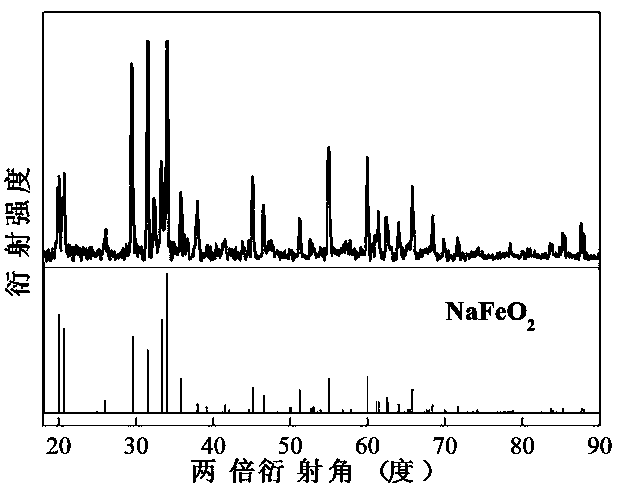Method for obtaining nano iron plating by direct electroplating
A technology of nano-iron and iron coating, applied in the direction of nanotechnology, nanotechnology, nanotechnology for materials and surface science, etc., can solve the problems of high requirements for raw materials, long production time, complicated process, etc., to achieve The effect of environmental protection process, environmental impact of recycling, and easy control of concentration
- Summary
- Abstract
- Description
- Claims
- Application Information
AI Technical Summary
Problems solved by technology
Method used
Image
Examples
Embodiment 1
[0019] 1) First Fe 2 o 3 The powder and flake NaOH were mixed at a mass ratio of 2:1, and calcined in air at 400°C for 4 hours to obtain pure NaFeO 2 powder, its XRD pattern is as figure 1 shown.
[0020] 2) Dissolve 100 grams of flake NaOH in 100 milliliters of distilled water to prepare a NaOH solution with a mass fraction of 50%, and place it in a 250 milliliter polytetrafluoroethylene beaker. Appropriate amount of NaFeO 2 The powder is dissolved in NaOH solution to obtain NaFeO 2 saturated solution.
[0021] 3) Put the polished and activated copper sheet (about 1 cm in diameter) and platinum wire as the cathode and anode respectively in the saturated solution, use a constant temperature controller and an electric heating mantle to control the temperature of the saturated solution to 25°C, and apply a constant voltage of 1.8 Volt plating for 3 hours. After electroplating, take out the cathode and rinse it with distilled water, then clean it with absolute alcohol, dry...
Embodiment 2
[0024] 1) First Fe 2 o 3 The powder and flake NaOH were mixed at a mass ratio of 2:1, and calcined in air at 400°C for 4 hours to obtain pure NaFeO 2 powder, its XRD pattern is as figure 1 shown.
[0025] 2) Dissolve 90 grams of flaky NaOH in 90 milliliters of distilled water to prepare a NaOH solution with a mass fraction of 50% and place it in a 250 milliliter polytetrafluoroethylene beaker. Appropriate amount of NaFeO 2 The powder is dissolved in NaOH solution to obtain NaFeO 2 saturated solution.
[0026] 3) The polished and activated copper sheet and platinum wire were respectively fixed in the saturated solution as the cathode and the anode, and the temperature of the saturated solution was controlled by a constant temperature controller and an electric heating mantle to 40°C, and a constant voltage of 1.8 volts was applied for 2 hours of electroplating. After electroplating, take out the cathode and rinse it with distilled water, then clean it with absolute alcoho...
Embodiment 3
[0029] 1) First Fe 2 o 3 The powder and flake NaOH were mixed at a mass ratio of 2:1, and calcined in air at 400°C for 4 hours to obtain pure NaFeO 2 powder, its XRD pattern is as figure 1 shown. .
[0030] 2) Dissolve 95 grams of flake NaOH in 95 milliliters of distilled water to obtain a 50% NaOH solution in a 250 milliliter polytetrafluoroethylene beaker. Appropriate amount of NaFeO 2 The powder is dissolved in NaOH solution to obtain NaFeO 2 saturated solution.
[0031] 3) The polished and activated copper sheet and platinum wire were respectively fixed in the saturated solution as the cathode and the anode, and the temperature of the saturated solution was controlled to 60°C with a constant temperature controller and an electric heating mantle, and a constant voltage of 1.8 volts was applied for 2.5 hours of electroplating. After electroplating, take out the cathode and rinse it with distilled water, then clean it with absolute alcohol, dry it and store it.
[003...
PUM
| Property | Measurement | Unit |
|---|---|---|
| particle size | aaaaa | aaaaa |
| particle size | aaaaa | aaaaa |
| particle size | aaaaa | aaaaa |
Abstract
Description
Claims
Application Information
 Login to View More
Login to View More - R&D
- Intellectual Property
- Life Sciences
- Materials
- Tech Scout
- Unparalleled Data Quality
- Higher Quality Content
- 60% Fewer Hallucinations
Browse by: Latest US Patents, China's latest patents, Technical Efficacy Thesaurus, Application Domain, Technology Topic, Popular Technical Reports.
© 2025 PatSnap. All rights reserved.Legal|Privacy policy|Modern Slavery Act Transparency Statement|Sitemap|About US| Contact US: help@patsnap.com



